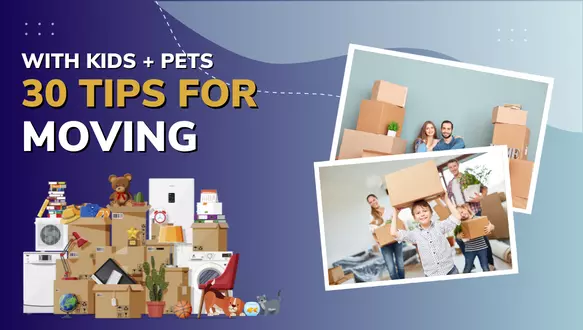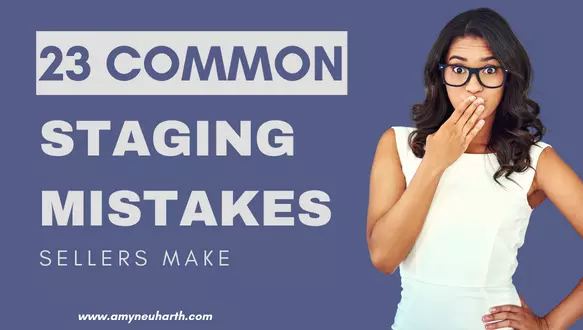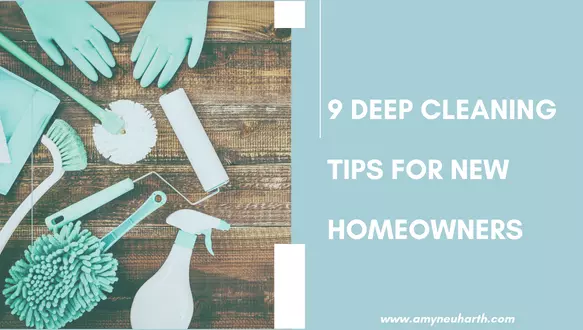
30 Tips for Moving with Kids or Pets
30 Tips for Moving with Kids or Pets Moving is stressful all on its own, but when you add in kids or pets (or both), it can feel downright impossible. But you can ensure the move is as low-stress for them, and you, as possible. Kids Consider the timing: Try not to layer a move on top of another stressful life event. Research the area: Help answer kids’ questions by learning about your new home. Communicate: Have age-appropriate conversations to help them prepare. Emphasize similarity: Give kids a good sense of what is NOT going to change. Plan: Figure out ways kids can participate — or get them out of the way. Offer choices: Paint color, furniture arrangement, hanging posters are all ways to give kids autonomy. Hire movers: This can really lower your stress levels and help you focus on your kids. Find an activity: Puzzles, books, or complicated new toys might be good ways to keep kids occupied if you can’t get them out of the house. Take advantage of night hours: Pack and remove items while kids are sleeping to streamline the process. Let kids help pack their things: This can help them feel like they have some control over the move. Help them say goodbye: If you’ll be leaving an area where you’ve lived for some time, help your kids prepare for this next step by saying goodbye. Prepare ‘overnight’ kits: A special stuffy or two, pajamas, a change of clothes, and so on will help kids transition more easily. Secure hotels in advance: Is there a pool? Will there be enough room for everyone? Make sure those questions are answered upfront if you’re on the road. Unpack their rooms first: Getting the kids’ bedrooms together can help them feel at home more quickly than you’d expect. Arrange furniture the same way: You’ll have plenty of time to move things around; for now, keeping things familiar can help kids adjust. Invest in surprises: Take kids somewhere fun or spring a gift on them to give them some positive feelings about their new home. Maintain routine: If your kids are used to an after-school snack, make sure it’s waiting for them — this isn’t the time to disrupt what’s soothing to them. Avoid disruption: Don’t start your kids in a new activity or push for a developmental stage right now. Keep calm: If you’re stressed out, your kids will be, too. Stay as cheerful and level-headed as you can during the move. Pets Acclimation: Get pets used to carriers, kennels, or cars Plan: Take pets to a day care, or keep their favorite room as intact as you can throughout the process. Hire movers: Professional packers and movers allow you to take your dog to the park while the move happens. Secure the animals: Don’t let any fur family members make a break for it while doors are open. Find an activity: A new, complicated toy can help occupy a pet during the move. Prepare ‘overnight’ kits: Plenty of food, a special toy or two, and familiar bedding or blankets can make a big difference to pets on the move. Secure hotels in advance: Will your pets be welcome and will there be enough room for them? Eliminate the chance that something could go wrong by booking ahead. Unpack a room for pets first: Scratching posts for cats, water and food, and toys — plus bedding and anything else that will help your pet feel at home — should be first off the truck. Arrange furniture the same way: Kids aren’t the only ones who benefit from a familiar arrangement. Pets can acclimate more quickly if you stick to your regular layout. Maintain routine: Walk the dog at the same time, stick to your feeding schedule, and do everything you can to keep things the same for pets, routine-wise. Keep calm: Your pets, of course, pick up on your mood. Try to make sure they’re only picking up happy, positive energy from you. Here is a FREE GUIDE TO MOVING WITH PETS, to keep on hand when it comes to the move!

23 Common Staging Mistakes Sellers Make
23 Common Staging Mistakes Sellers Make Staging a home isn't an exact science — it's more of an art, one that covers several rooms and flows throughout a home. The goal is to create a warm, welcoming space that will resonate with buyers. Here are the biggest mistakes you can make when staging your house for sale. An un-staged room: Unless you’re in a very strong seller’s market, you should consider light staging. Wall-to-wall furniture: Most of our homes contain too many items for staging to work well. Closets stuffed full of items: Hiding stuff instead of eliminating it won’t work when buyers peek inside closets. Cluttered surfaces: Give your home the best chance of hooking a buyer by clearing surfaces of clutter. Closed doors: Closed doors can give buyers a sense that you’re hiding something (and they’re just going to open them, anyway). Shabby carpet: Tired carpeting and peeling linoleum aren’t a good look in any home. Toys and books in the corner: How many is “too many” books or toys? You need to eliminate as much as you can. An (almost empty) staged room: Too little furniture is almost as bad as too much; a nearly empty room will look strange. Water stains on a wall corner: Ignoring critical improvements is just as bad as not staging at all. Patchy paint: Sprucing up your paint is easy and makes the room look pulled together; failing to do that is a mistake. Furniture too small for the room: You don’t have to fit your home’s scale exactly, but too-big or too-small items will make your rooms look off. Minimal/modernist décor: Clean, minimalist lines are all the rage, but these styles aren’t the most homelike. One aesthetic everywhere: Buyers who walk through might think this looks lovely, but they won’t see themselves living in it. Narrow, neutral color palettes: In rooms where everything is one color, nothing really stands out. A staged room Fake flowers: They’re easier to keep “alive,” but fake flowers and plants can make a house feel, well, fake. Family pictures on the wall: Buyers won’t be able to see themselves in a house full of your personal items. Collectible artwork: Museum showpieces can alienate buyers; best leave the collectible artwork stored away. Bare floors: Carpets or rugs can help provide structure and flow to rooms; forgetting them can make rooms feel adrift in a sea of house. Trying too hard: Over-staging makes sellers feel like they’re in a movie, not a real house. A staged room Cat litter box in the corner: Focusing only on sight means you’ll miss other ways that buyers are put off your house. Gorgeous picture window — with bookshelf in front of it: Don’t block views or architectural features with your furniture. Home exterior Patchy lawn: Don’t ignore curb appeal — your buyers sure won’t. Empty flowerpots: When you miss an opportunity to add plants or flowers, you’re missing out on the chance for your house to feel vibrant and alive. Here is a FREE photography preparation checklist to help you when it comes to preparing your home for professional photos! It will help to also avoid these mistakes when you are listing your home. When you are ready to sell your home - CONTACT ME and we can get to work!

9 Tips for Assessing Your Home's Value
As a homeowner, it's perfectly natural to wonder how much your house is worth. Here are nine things to consider when you're trying to figure out your home’s current value. Look at your property tax bill Your property tax bill is a good jumping-off point. In most states, homes are assessed for taxes every five to seven years. But an assessment isn’t the final word on property value; it’s based on your home’s most recent appraised value. Examine homes that have sold recently in your neighborhood To pinpoint a home's value, most professionals use "comps” — this is just a term for homes that are comparable to yours that have sold recently. Find some comps yourself by looking up homes that have recently sold in your area or neighborhood. The recently sold homes should be as, well, comparable to your house as possible for this to be a valuable exercise. Consider inventory In some markets where there just aren't very many homes for sale, it might not even matter that much if your house is comparable to others that have recently sold. Those markets are few and far between, but it's still a smart idea to look at how many homes are for sale in terms of total inventory and then use that information to determine how much your own house might be worth. Use an online tool Although online tools for calculating your home's value are everywhere, they aren't always accurate. A robot or algorithm hasn't actually seen your house; they haven't walked through it to determine whether the flooring, finishes, appliances, and other details are above the market average or below market average. Nonetheless, if you want a quick answer, sometimes an online tool is the fastest way to get at least a ballpark range. Determine price per square foot in your area Another way to determine your home's value is to look at the average price per square foot in your area, take your own home's square footage, and do a little bit of math. But price per square foot can be tricky, so make sure you're being smart when you use it to calculate your own home's value (for example, appraisers won’t include your basement in your home’s square footage, or gross living area). Consider the home's age, the lot size, and the location The house itself is just one part of the valuation equation, although it's an important one. Even if your house has increased in value since you bought it, just like any other physical asset, homes degrade over time. The land that the house sits upon is also critical when you're trying to figure out how much the house is worth, both in terms of its exact location and also in terms of how much land there is. Be realistic about how your home measures up Everyone wants to believe that the house where they've been living, breathing, and making memories is one of the best homes in the neighborhood. But ultimately, your house is only worth what a buyer would pay to own it, and delusions about how special it is could undercut your home's actual worth if you end up overpricing it. Order a BPO or a CMA A BPO is a broker price opinion, and a CMA is a comparative market analysis; you can get either of these documents from a licensed real estate agent, who likely knows the market very well. After all, they list and sell houses every day, so they probably have a pretty good idea of what yours is worth. Talk to a professional A real estate agent or broker isn't the only person who can assess your home's value; you can also go straight to an appraiser and order an appraisal but be aware that it could take several weeks and cost a few hundred dollars to get their professional opinion. So an agent or broker might be your best option if you want to save money and you're not interested in selling your house immediately.
Categories
Recent Posts










